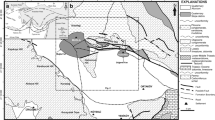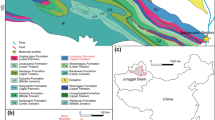Abstract
The Jianglangshan Geopark in the western Zhejiang Province of Southeast China is well-known for its spectacular red-colored sandstone landforms. Little is known about the depositional processes of the conglomerate-dominated Fangyan Formation, the lithologic base of the Danxia landforms in this geopark. Based on detailed field investigation of lithology, sedimentary structures, bed thickness and geometry, five facies are recognized: facies A (matrix-supported cobble conglomerate), facies B (pebble conglomerate), facies C (pebbly sandstone), facies D (fine-grained sandstone) and facies E (mudstone). The results show that streamflow-dominated fans were the main depositional processes responsible for the accumulation of the Fangyan Formation along the mountain fronts. These fan conglomerates form the base for the evolution of the Danxia landscapes owing to the uplift and erosion of the study area. In contrast, the fine-grained sedimentary successions produced by fluvial floodplains in the distal part of the fans were thinner and more easily weathered. Such sedimentary facies distribution patterns were thought to be similar during Late Cretaceous across Southeast China. The Danxia landforms are largely the geographical expressions of the conglomerate-dominated redbeds in the proximal-middle fans.
Similar content being viewed by others
References
Blair TC, McPherson JG (2009) Processes and forms of alluvial fans. In: Parsons AJ, Abrahams AD (eds.), Geomorphology of Desert Environments (2nd edition). Springer Science + Business Media B. V. 413–467. DOI: 10.1007/978-1-4020-571 9-9_14
Blair TC (1999) Cause of dominance by sheetflood versus debris-flow processes on two adjoining alluvial fans, Death Valley, California. Sedimentology 46(6): 1015–1028. DOI: 10.1046/j.1365-3091.1999.00261.x
Bull WB (1972) Recognition of alluvial fan deposits in the stratigraphic record. In: Rigby JK, Hamblin WK (eds.), Recognition of ancient sedimentary environments. SEPM Special Publication 16: 63–83
Cao K (2013) Cretaceous terrestrial stratigraphic correlation in China. Geological Review 59(1): 24–40. (In Chinese)
Chan KT (1938) On the subdivisions of the redbeds of South-Eastern China. Bulletin of the Geological Society of China 18(3–4): 301–324. DOI: 10.1111/j.1755-6724.1938.mp183-4008.x
Chen LQ, Guo FS, Tang C (2016) Evolution of the Late Cretaceous Yongfeng-Chongren Basin in Jiangxi Province, Southeast China: insights from sedimentary facies analysis and pebble counting. Journal of Mountain Science 13(2): 342–351. DOI: 10.1007/s11629-014-3387-4
Chen PJ (2000) Comments on the classification and correlation of non-marine Jurassic and Cretaceous of China. Journal of Stratigraphy 24(2): 114–119. (In Chinese)
Chen PJ (1997) Coastal mountains of SE China, desertization and saliniferous lakes of Central China during the Upper Cretaceous. Journal of Stratigraphy 21(3): 203–213. (In Chinese)
Gilder SA, Keller GR, Luo M, et al. (1991) Eastern Asia and the western Pacific timing and spatial distribution of rifting in China. Tectonophysics 197(2–4): 225–243. DOI: 10.1016/0040-1951(91)90043-R
Groom KM, Allen, CD, Mol L, et al. (2015) Defining tafoni: Reexamining terminological ambiguity for cavernous rock decay phenomena. Progress in Physical Geography 39(6): 775–793. DOI: 10.1177/0309133315605037
Guo FS, Li XY, Jiang YB, et al. (2012) Danxia landform in Mount Longhushan and its tourism development. Beijing: Geological Publishing House. (In Chinese)
Guo FS, Zhu ZJ, Huang BH, et al. (2013) Cretaceous sedimentary system and their relationship with Danxia landform in Xinjiang Basin, Jiangxi. Acta Sedimentologica Sinica 31(6): 954–964. (In Chinese)
Huang J, Chen ZJ, Qi DL (2015) Study on Distribution of Danxia landform in China (first). Mountain Research 33(4): 385–396. (In Chinese) DOI: 10.16089/j.cnki.1008-2786. 000049
Imaizumi F, Tsuchiya S, Ohsaka O (2016) Field observations of debris-flow initiation processes on sediment deposits in a previous deep-seated landslide site. Journal of Mountain Science 13(2): 213–222. DOI: 10.1007/s11629-015-3345-9
Jiang YB, Guo FS, Hu ZH, et al. (2010) A study on the features of Danxia landform and its landscape types in Xinjiang Basin. Mountain Research 28(4): 502–512. (In Chinese)
Jiangxi Bureau of Geology (1982) 1:200,000 Geological map of the People's Republic of China (Guangfeng). (In Chinese)
Jullien R, Meakin P, Paviovitch A (1992) Three-dimensional model for particle-size segregation by shaking. Physical Review Letters 69(4): 640–643. DOI: 10.1103/PhysRevLett.69.640
Kraus MJ (1999) Paleosols in clastic sedimentary rocks: their geologic applications. Earth-Science Reviews 47(1–2): 41–70. DOI: 10.1016/s0012-8252(99)00026-4
Kusky TM, Ye MH, Wang JP, et al. (2010) Geological evolution of Longhushan World Geopark in relation to global tectonics. Journal of Earth Science 21(1): 1–18. DOI: 10.1007/s12583-010-0009-0
Li RL, Li ZZ (2010) SHRIMP zircon U-Pb age of late Mesozoic basaltic magmatism in the Yujiang region, Southeast China and its implication. Journal of Mineralogy and Petrology 30(2): 45–49. (In Chinese)
Major JJ (1998) Pebble orientation on large, experimental debris-flow deposits. Sedimentary Geology 117(3): 151–164. DOI: 10.1016/S0037-0738(98)00014-1
Mustoe GE (2010) Biogenic origin of coastal honeycomb weathering. Earth Surface Processes and Landforms 35(4): 424–434. DOI: 10.1002/esp.1931
Nemec W, Steel RJ (1984) Alluvial and coastal conglomeratestheir significant features. In: Koster EH, Steel RJ (Eds.), Sedimentology of Gravels and Conglomerates. Canadian Society of Petroleum Geologists, Memoir 10: 1–31
Shu LS, Zhou XM, Deng P, et al. (2009) Mesozoic tectonic evolution of the Southeast China Block: New insights from basin analysis. Journal of Asian Earth Sciences 34(3): 376–391. DOI: 10.1016/j.jseaes.2008.06.004
Sohn YK, Rhee CW, Kim BC (1999) Debris flow and Hyperconcentrated flood-flow deposits in an alluvial fan, northwestern part of the Cretaceous Yongdong basin, Central Korea. The Journal of Geology 107(1): 111–132. DOI: 10.1086/314334
Ouyang J, Zhu C, Peng H, et al. (2009) Types and spatial combinations of Danxia landform of Fangyan in Zhejiang Province. Journal of Geographical Sciences 19(5): 631–640. DOI: 10.1007/s11442-009-0631-x
Peng H (2001) Danxia geomorphology of China: a review. Chinese Science Bulletin 46(Supp.): 38–45. DOI: 10.1007/BF03187234
Peng H, Ren F, Pan ZX (2015) A review of Danxia landforms in China. Zeitschrift für Geomorphologie 59(Suppl.1): 19–33. DOI: 10.1127/zfg_suppl/2015/S-00173
Steel RJ (1974) New Red Sandstone floodplain and piedmont sedimentation in the Hebridean Province, Scotland. Journal of Sedimentary Research 44(2): 336–357. DOI: 10.1306/74D72A27-2B21-11D7-8648000102C1865D
Tabor NJ, Myers TS (2015) Paleosols as indicators of paleoenvironment and paleoclimate. Annual Review of Earth and Planetary Sciences 2015, 43: 333–361. DOI: 10.1146/annurev-earth-060614-105355
Tucker GE, Hancock GR (2010) Modelling landscape evolution. Earth Surface Processes and Landforms 35(1): 28–50. DOI: 10.1002/esp.1952
Turkington AV, Paradise TR (2005) Sandstone weathering: a century of research and innovation. Geomorphology 67(1): 229–253. DOI: 10.1016/j.geomorph.2004.09.028
Turkington AV, Phillips JD (2004) Cavernous weathering, dynamical instability and self-organization. Earth Surface Processes and Landforms 29(6): 665–675. DOI: 10.1002/esp.1060
Wang DZ, Shu LS (2012) Late Mesozoic basin and range tectonics and related magmatism in Southeast China. Geoscience Frontiers 3(2): 109–124. DOI: 10.1016/j.gsf.2011. 11.007
Wu JH, Xiang YX, Zhong ZF (2014) SHRIMP zircon U-Pb dating and Sr-Nd-Pb-O isotope characteristics of shoshonite from Guangfeng and Yushan basins in Jiangxi Province. Acta Petrologica Et Mineralogica 33(4): 645–656. (In Chinese)
Wu YY, Feng RC, Yue T, et al. (2015) Characteristics of the Cretaceous alluvial fans in Yongkang and Jinqu Basins, central and western Zhejiang Province. Journal of Palaeogeography 17(2): 160–171. DOI: 10.7605/gdlxb.2015.02. 014 (In Chinese)
Yan ZZ, Du XP, Fan XT (2015) Numerical simulation of the evolutionary process of Danxia landforms. Physical Geography 36(4): 322–336. DOI: 10.1080/02723646.2015. 1033047
Young RW, Wray RAL, Young ARM (2009) Sandstone landforms. Cambridge University Press, Cambridge
Zhao T, Zhao X, Peng H, et al. (2014) A Tentative Discussion on the Definition and Classification of Danxia Landform. Acta Geoscientica Sinica 35(3): 375–382. (In Chinese)
Zhu C, Peng H, Li ZX, et al. (2009) Age and genesis of the Danxia landform on Jianglang Mountain, Zhejiang Province. Journal of Geographical Sciences 19(5): 615–630. DOI: 10.1007/s11442-009-0615-x
Zhu C, Wu L, Zhu TX, et al. (2015) Experimental studies on the Danxia landscape morphogenesis in Mt. Danxiashan, South China. Journal of Geographical Sciences 25(8): 943–966. DOI: 10.1007/s11442-015-1212-9
Acknowledgements
This research was supported by the National Natural Science Foundation of China (Grant No. 41602113), the Open Research Fund from the State Key Laboratory Breeding Base of Nuclear Resources and Environment (East China University of Technology) (Grant No. NRE1605). Dr. YANG Qing-kun and graduate students ZHANG Jie-wei and XUAN Pu-yan helped measure the outcrop section in the field investigation. We are also grateful to the reviewers whose critical and helpful comments greatly improved the early version of the manuscript.
Author information
Authors and Affiliations
Corresponding author
Additional information
http://orcid.org/0000-0002-4373-5520
http://orcid.org/0000-0001-5968-5153
Rights and permissions
About this article
Cite this article
Chen, Lq., Guo, Fs. Upper Cretaceous alluvial fan deposits in the Jianglangshan Geopark of Southeast China: implications for bedrock control on Danxia landform evolution. J. Mt. Sci. 14, 926–935 (2017). https://doi.org/10.1007/s11629-016-4024-1
Received:
Revised:
Accepted:
Published:
Issue Date:
DOI: https://doi.org/10.1007/s11629-016-4024-1




